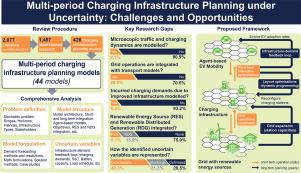Multi-period Charging Infrastructure Planning under Uncertainty: Challenges and Opportunities
IF 10.5
1区 工程技术
Q1 CONSTRUCTION & BUILDING TECHNOLOGY
引用次数: 0
Abstract
Long-term charging infrastructure planning is imperative to sustain the rapid adoption of electric vehicles (EVs) in line with climate goals. While the literature on spatial planning of charging infrastructure is well documented, the temporal dimension has received limited attention. This paper comprehensively reviews the literature on multi-period charging infrastructure planning under uncertainty. It examines the complex interplay between EV mobility and the energy sector. Four gaps are identified after examining 44 pertinent studies published from January 1990 to March 2024. Firstly, current models are predominantly deterministic and myopic, lacking a forward-looking approach to accommodate future uncertainties. Secondly, most studies rely on EVs’ aggregated mobility and charging patterns, leading to inaccurate charging demand forecasts and suboptimal plans. Addressing this requires integrating vehicle-level agent-based models that accurately depict EVs’ charging patterns, and their interactions with charging stations and the grid. Thirdly, the impact of improved charging infrastructure on EV adoption is generally ignored. Joint consideration of charging demand forecasting with infrastructure planning is essential to incorporate such infrastructure-demand feedback loops. Lastly, current planning frameworks show limited integration of grid expansion, operations, and renewable energy sources To address these gaps, we propose a dynamic programming-based framework and solution approach to this planning problem.

不确定性下的多期充电基础设施规划:挑战与机遇
要使电动汽车(EV)的快速普及与气候目标保持一致,就必须进行长期的充电基础设施规划。有关充电基础设施空间规划的文献已被大量引用,但对时间维度的关注却很有限。本文全面回顾了不确定性条件下多期充电基础设施规划方面的文献。它研究了电动汽车流动性与能源部门之间复杂的相互作用。在研究了 1990 年 1 月至 2024 年 3 月期间发表的 44 篇相关研究后,发现了四个差距。首先,目前的模型主要是确定性和近视性的,缺乏前瞻性的方法来考虑未来的不确定性。其次,大多数研究依赖于电动汽车的综合移动性和充电模式,导致充电需求预测不准确和计划不理想。要解决这个问题,需要整合基于车辆级代理的模型,准确描述电动汽车的充电模式,以及它们与充电站和电网之间的互动。第三,改善充电基础设施对电动汽车应用的影响通常被忽视。将充电需求预测与基础设施规划结合起来考虑,对于纳入此类基础设施需求反馈回路至关重要。最后,目前的规划框架对电网扩展、运营和可再生能源的整合有限。 为了弥补这些不足,我们针对这一规划问题提出了基于动态编程的框架和解决方法。
本文章由计算机程序翻译,如有差异,请以英文原文为准。
求助全文
约1分钟内获得全文
求助全文
来源期刊

Sustainable Cities and Society
Social Sciences-Geography, Planning and Development
CiteScore
22.00
自引率
13.70%
发文量
810
审稿时长
27 days
期刊介绍:
Sustainable Cities and Society (SCS) is an international journal that focuses on fundamental and applied research to promote environmentally sustainable and socially resilient cities. The journal welcomes cross-cutting, multi-disciplinary research in various areas, including:
1. Smart cities and resilient environments;
2. Alternative/clean energy sources, energy distribution, distributed energy generation, and energy demand reduction/management;
3. Monitoring and improving air quality in built environment and cities (e.g., healthy built environment and air quality management);
4. Energy efficient, low/zero carbon, and green buildings/communities;
5. Climate change mitigation and adaptation in urban environments;
6. Green infrastructure and BMPs;
7. Environmental Footprint accounting and management;
8. Urban agriculture and forestry;
9. ICT, smart grid and intelligent infrastructure;
10. Urban design/planning, regulations, legislation, certification, economics, and policy;
11. Social aspects, impacts and resiliency of cities;
12. Behavior monitoring, analysis and change within urban communities;
13. Health monitoring and improvement;
14. Nexus issues related to sustainable cities and societies;
15. Smart city governance;
16. Decision Support Systems for trade-off and uncertainty analysis for improved management of cities and society;
17. Big data, machine learning, and artificial intelligence applications and case studies;
18. Critical infrastructure protection, including security, privacy, forensics, and reliability issues of cyber-physical systems.
19. Water footprint reduction and urban water distribution, harvesting, treatment, reuse and management;
20. Waste reduction and recycling;
21. Wastewater collection, treatment and recycling;
22. Smart, clean and healthy transportation systems and infrastructure;
 求助内容:
求助内容: 应助结果提醒方式:
应助结果提醒方式:


